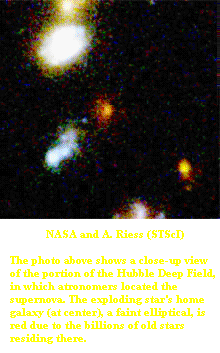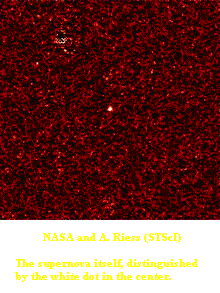 |
Reference: http://www.nytimes.com/2001/04/03/science/03STAR.html
A photograph of a distant exploding star has given astronomers the first direct evidence that a mysterious “negative gravity” force swept through and still pervades the universe, scientists announced at a NASA news conference yesterday in Washington.
The Hubble Space Telescope by chance photographed the exploding star, the most distant ever observed, in 1997. Scientists say subsequent detective work on the relative intensity of its light confirms one of Einstein’s conjectures about the universe: that all of space is bubbling with an invisible form of energy that creates a mutual repulsion between objects normally attracted to each other by gravity.
 Einstein himself thought the force, which he called the cosmological constant, was so strange that he later repudiated his conjecture. But the idea gained theoretical support in 1998 with findings suggesting that the expansion of the universe was accelerating and that the force accelerating the expansion, negative gravity — the manifestation of the cosmological constant — overtook the force of gravity in the last few billion years.
Einstein himself thought the force, which he called the cosmological constant, was so strange that he later repudiated his conjecture. But the idea gained theoretical support in 1998 with findings suggesting that the expansion of the universe was accelerating and that the force accelerating the expansion, negative gravity — the manifestation of the cosmological constant — overtook the force of gravity in the last few billion years.
The new findings confirm that crucial part of the theory. And they rule out several competing explanations.
Because the amount of negative gravity in any given volume should be minuscule, its effects would not be felt in everyday life. But over vast distances involving huge volumes of space, the effect would be powerful enough to push galaxies and clusters of galaxies apart from one another.
Exploding stars, or supernovas, like the one that turned up unexpectedly on a photograph made by the Hubble telescope, can be excellent probes of those grand forces. The new observation is of a star that exploded about 11 billion years ago, when the universe was a quarter of its present age and when, scientists theorized, the cosmological constant, often called “dark energy,” was less powerful than gravity, the opposite of what prevails today.
As a result, the expansion of the universe was slowing at that time. This meant that the star was closer to earth when it exploded than it would have been if dark energy had dominated gravity then — a fact discernable in its brightness. Astronomers said it was twice as bright as it would have been under competing theories about the universe.
A team led by Dr. Adam G. Riess, an astrophysist at the Space Telescope Science Institute in Baltimore analyzed the data. Dr. Riess, who worked with Dr. Peter E. Nugent of Lawrence Berkeley National Laboratory, said the measurement “nails the existence of the dark energy.”
Dr. Michael S. Turner, an astrophysicist at the University of Chicago not involved in the work, called the dark energy “one of the most important discoveries in all of science.”
“If Einstein were around today, he would get another Nobel Prize for his prediction of repulsive gravity,” Dr. Turner said.
He added that research would now shift to a hunt for the source of the energy and efforts to observe many other distant supernovas to pin down the characteristics of the dark energy.
The universe is expanding as a legacy of its violent birth, which is believed to have occurred in a great explosion or “big bang” roughly 14 billion years ago. Until recently, scientists were all but certain that the gravitational attraction among the galaxies would slow the expansion.
But in 1998, two teams began presenting data on supernovas that they had observed as a way to measure the change in the expansion rate over the last few billion years. They used a class of supernovas that explode with nearly the same brightness each time, like bulbs of a known wattage. This constancy enabled scientists to measure the speed at which the expansion of the universe had swept these supernovas away: the dimmer they appeared from earth, the farther away they were.
Those observations revealed unexpectedly dim supernovas, suggesting that something, perhaps clouds of cosmic dust, was obscuring them or that they were farther away than expected, perhaps driven away by an anti-gravity force.
To find the explanation, astronomers tried to observe objects so distant that their light had been traveling to Earth for billions of years.
“You need things that you can see across to the other side of the universe,” Dr. Nugent said.
If cosmic dust were dimming this light, they reasoned, the objects would be dimmer the farther they were from Earth. But if Einstein’s explanation were correct, extremely distant supernovas should appear to brighten relative to some standard, rather than continuing to dim.
 Because they are so faint and are obscured by Earth’s atmosphere, very distant supernova explosions are rarely seen. But a break came in 1997 when teams led by Dr. Ronald L. Gilliland of the space telescope institute and Dr. Mark Phillips of the Carnegie Institution of Washington made long-exposure Hubble photographs of a tiny part of the sky. The pictures revealed a supernova in the distant gloom of space.
Because they are so faint and are obscured by Earth’s atmosphere, very distant supernova explosions are rarely seen. But a break came in 1997 when teams led by Dr. Ronald L. Gilliland of the space telescope institute and Dr. Mark Phillips of the Carnegie Institution of Washington made long-exposure Hubble photographs of a tiny part of the sky. The pictures revealed a supernova in the distant gloom of space.
A difficult and time-consuming analysis of light from the star showed that it was twice as bright as it would have been if cosmic dust had been obscuring it or, as another hypothesis held, if supernovas had somehow evolved steadily in brightness over the history of the cosmos.
The finding, said Dr. Saul Perlmutter, a physicist and supernova-hunter at the Berkeley laboratory not involved in the work, was “not very consistent with simple dust or evolution models.”
“That’s the standout story here,” Dr. Perlmutter said.
Cosmologists will have to cope with a universe that seems increasingly filled with mysterious stuff that scientists cannot see and do not fully understand. The dark energy joins dark matter as an invisible constituent of the cosmos. Dark matter’s gravitational effects are known, and despite its invisibility it is presumed to give the universe much of its mass.
Physicists will try to explain the source and exact nature of the dark energy. Dr. Turner said these questions appeared to lie at the crossroads of several of the most important problems in physics.
“In ‘The Graduate,’ that guy told young Dustin Hoffman, ‘plastics,’” Dr. Turner said. “My advice to the next generation of particle physicists and astrophysicists: dark energy.”
![]()
HYPERLINKS:
Index and Direct Hyperlinks to the Other Web Pages on this Website:
- Gravity Warp Drive Home Page
- Nuclear Gravitation Field Theory
- History of My Research and Development of the Nuclear Gravitation Field Theory
- “The Zeta Reticuli Incident” by Terence Dickinson
- Supporting Information for the Nuclear Gravitation Field Theory
- Government Scientist Goes Public
- The Physics of Star Trek and Subspace Communication: Science Fiction or Science Fact?
- “Sport Model” Flying Disc Operational Specifications
- Design and Operation of the “Sport Model” Flying Disc Anti-Matter Reactor
- Element 115
- Bob Lazar’s Gravity Generator
- United States Patent Number 3,626,605: “Method and Apparatus for Generating a Secondary Gravitational Force Field”
- United States Patent Number 3,626,606: “Method and Apparatus for Generating a Dynamic Force Field”
- V. V. Roschin and S. M. Godin: “Verification of the Searl Effect”
- Constellation: Reticulum
- Reticulan Extraterrestrial Biological Entity
- Zeta 2 Reticuli: Home System of the Greys?
- UFO Encounter and Time Backs Up
- UFO Testimonies by Astronauts and Cosmonauts and UFO Comments by Presidents and Top U.S. Government Officials
- Pushing the Limits of the Periodic Table
- General Relativity
- Rethinking Relativity
- The Speed of Gravity - What the Experiments Say
- Negative Gravity
- The Bermuda Triangle: Space-Time Warps
- The Wright Brothers
- Favorite Quotes from Famous People
- Sponsors of This Website
- Romans Road to Eternal Life In Jesus Christ
![]()